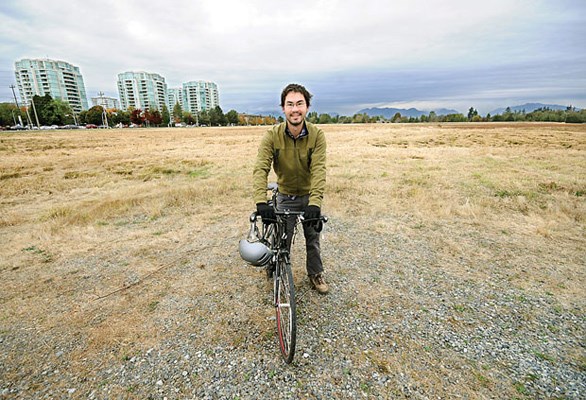Should it be state-of the-art sports fields, a giant tapestry of community gardens and organic farms, a splendid nature park or all of the above?
The potential suitors are lining up to stake their claims for a share of the much sought after Garden City Lands.
Over the next 18 months a public consultation and planning process compressed from three years by city council several community groups will make their case to city council to fulfill their specific needs.
And with the $60 million 136.5-acre site locked in the Agricultural Land Reserve (ALR), out of developers grasp, it can only be used for agriculture or recreation.
Richmond Sports Council chair Jim Lamond, no stranger to bidding to get sport played on the rare, sprawling green space, will again step up and make a similar argument to the one hes been doing for the last 30 years.
We hope to put together another facility task force report, said Lamond, who showed the News a copy of the failed bid for Richmond to host the 1994 Commonwealth Games on the northern half of Garden City Lands.
Weve done this five times before over the past few decades and were still hoping to get a piece of the lands for sport. We are going to be very involved in the process, thats for sure.
The 1994 event eventually went the way of Victoria and a subsequent city-wide referendum on continuing with the plan to build the sports facilities on the lands also failed.
We would definitely like to see part of it set aside for sports, added Lamond.
This has been the goal for the city over the last 30 years. When we bid for the 1994 games, we were going to have a stadium, a velodrome, sports fields, an aquatic centre and indoor sports halls.
People will say we have the oval now, but the oval is just designed for elite athletes, this is about community sport.
When we try to host large events, we dont really have a stadium for it.
Colin Dring, Richmond Food Security Societys executive director, said his organization would love to, ideally, see community gardens sprout on the lands, as well as some agricultural education space.
At least half of the lands have great conservation value for the bog system and it would be good to see the site be showcased environmentally, said Dring.
For food production, we have between 150 and 200 people waiting for community garden lots in Richmond.
And we would definitely speak for small scale organic farmers; theres about 40 to 50 acres out there that could be sublet to farmers at two to four acres a time to grow food for the local market.
Dring acknowledged the assertion from some quarters that the nature of the bog soil is not conducive to growing food.
It depends what you want to grow and how much time people are prepared to put into the soil to produce the potential for agriculture, explained Dring.
We might struggle to grow bananas out there, but we dont seem to have a problem growing, for example, blueberries and cranberries in that kind of soil.
One man whos fought long and hard to conserve the lands, Garden City Lands Coalition president Jim Wright, said all he wants is for the site to be used within the letter of the law.
We dont try to suggest particular uses, we just want it to be used in a way thats consistent with the law, he said.
The law that takes precedence is the Agricultural Land Commission (ALC) law.
Its recognized that it should be used for agriculture and recreation, the people were quite clear about what they wanted.
Wright thinks people like the open, natural feeling that comes with the lands.
Thats a really basic thing; along with the opportunity to grow things.
The city announced last month that its preparing to embark on a detailed planning process for the lands, which is projected to cost in the region of $300,000.
This is despite the fact that the Musqeaum Nation, which sold its rights to the land in 2010 for $60 million, is challenging the legality of the sale through the courts.
The nation claimed it had no alternative but to accept the citys offer, since the land remained locked in the ALR, and blamed the city for not doing everything it was legally obliged to do to have it removed from the ALR.
It also claimed the memorandum of understanding (MOU) the city signed in 2005 is still in effect, and has asked the court to make a ruling to that effect.
While the city admits it never specifically spelled out in the sale agreement that the sale nullified the MOU, it did state in the sale agreement that the land would be handed over free and clear of all encumbrances, according to the citys statement of defence.



